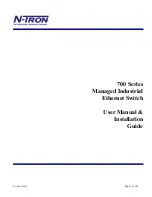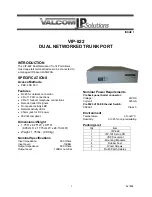
2
Copyright © 2011 ADTRAN, Inc. All Rights Reserved.
Quick Start Guide, 61700515E2-13D, March 2011
3
1.
Connect the DB-9 (male) connector of your serial cable to the
CONSOLE
port located on
the rear panel of the unit.
2.
Connect the other end of the serial cable to the terminal or PC.
3.
Provide power to the unit as appropriate. Refer to the
NetVanta 1335 Series Hardware
Installation Guide
(ADTRAN’s Knowledge Base article 3105) available online at
http://kb.adtran.com
for more details.
4.
Once the unit is powered up, open a VT100 terminal session using the following settings:
9600 baud, 8 data bits, no parity bits, 1 stop bit, and no flow control. Press
<Enter>
to
activate the AOS CLI.
5.
Enter
enable
at the
>
prompt and enter the Enable mode password when prompted. The
default password is
password
.
You can also access the CLI from a Telnet client. In order to do this, you must know the IP
address of the AOS device. If you do not know the unit’s IP address, you must use the
CONSOLE
port to access the CLI. To access the CLI using a Telnet client, follow these steps:
1.
Connect the unit to your PC using any of the ports on the front of the unit and an Ethernet
cable.
2.
Open a Telnet client on your computer. You can access the Telnet client by navigating to
Start
>
Run
and entering
telnet 10.10.10.1
(Windows® XP). If you are running Windows
Vista, you will need to turn on the Telnet client before you access it. To do this, navigate to
Start
>
Control Panel
>
Programs and Features
>
Turn Windows features on or off
>
Telnet Client Option
and select
OK
.
10.10.10.1
is the default unit IP address. If you have
changed your unit’s IP address, you will need to enter that address.
3.
Enter
enable
at the
>
prompt and enter the enable password when prompted. The default
password is
password
.
C
OMMON
CLI C
OMMANDS
The following are common CLI commands and tips for getting started with the CLI.
•
Entering a question mark (?) shows contextual help and options. For example, entering
?
at
the prompt will show all commands available from that prompt.
•
To view interface statistics, enter
show interface
<interface type> <interface number>
.
•
To view the current configuration, enter
show running-config
.
•
To view all the IP addresses currently configured, enter
show ip interface brief
.
•
To view the AOS version, serial number, and other information, enter
show version
.
•
To save the current configuration, enter
write
.
Many PCs do not come with a standard serial port. A universal serial
bus (USB) to serial adapter can be used instead. The drivers for the USB
to serial adapter must be installed according to the manufacturer’s
instructions. If the USB to serial adapter is not properly installed on your
PC, you will not be able to communicate with the AOS unit and you
should seek support from the USB to serial adapter manufacturer.
P
OWER
OVER
E
THERNET
The NetVanta 1335 PoE (P/N 1700525E2) is a Power over Ethernet (PoE) switch. PoE switches
provide the ability to detect attached powered devices (PDs) and deliver 48 VDC to the PD via
existing Ethernet cabling. The NetVanta 1335 PoE is fully compliant with the IEEE 802.3af PoE
and IEEE 802.3at PoE+ standards. By default, the PoE switches discover and provide power to
IEEE-compliant PDs.
To disable power detection and supply, use the
power inline never
command in the CLI. To
disable power detection and supply from the GUI, select the
Ports
page. Then select a single port
from the list (e.g.,
switchport 0/1
). This will bring up the port detail page for
switchport 0/1
. On
this page, there is a check box to enable power detection.
C
ONFIGURE
THE
U
NIT
’
S
IP A
DDRESS
The following steps create an IP address and subnet mask for the virtual local area network
(VLAN) interface
vlan 1
. If you are not sure what IP address to assign, please contact your
network administrator.
1.
At the
#
prompt, enter
config terminal
.
2.
At the
(config)#
prompt, enter
interface vlan 1
to access the configuration parameters for
the VLAN interface.
3.
Enter
ip address 10.26.12.12 255.255.255.0
to assign an IP address to the VLAN interface
using a 24-bit subnet mask.
4.
Enter
no shutdown
to activate the VLAN interface to pass data.
5.
Enter
exit
to return to the Global Configuration mode.
6.
Enter
ip route 0.0.0.0 0.0.0.0 192.168.1.254
to add a default route to the route table.
0.0.0.0
is the default route and the default subnet mask, and
192.168.1.254
is the next-hop IP
address to which the AOS unit should send all of its traffic. You will need to enter the proper
route, subnet mask, and gateway for your network. This information is typically provided by
an Internet service provider (ISP) or local network administrator.
7.
Enter
do write memory
to save the current configuration.
E
NABLE
T
ELNET
U
SER
L
OGIN
A
CCESS
The following steps enable user login parameters for Telnet access by changing the password
from the default (
password
) and enabling security login on Telnet lines.
1.
Verify that the prompt of your unit displays
(config)#
.
2.
Enter
line telnet 0 4
to change the configuration parameters for the Telnet sessions.
3.
Enter
login
to prompt users with a login prompt for Telnet access.
4.
Enter
password adtran
to change the login password for the Telnet sessions.
5.
Enter
exit
to return to the Global Configuration mode.
6.
Verify that the prompt of your unit displays
(config)#
.
7.
Enter
do write memory
to save the current configuration.
The configuration parameters used in the examples outlined in this
document are for instructional purposes only. Please replace all
underlined entries (
example
) with your specific parameters to configure
your application.






















